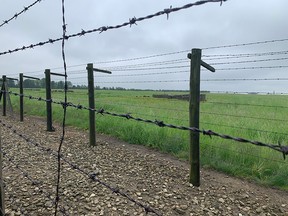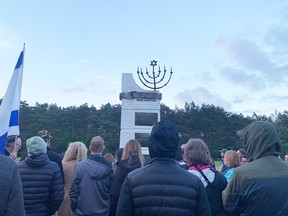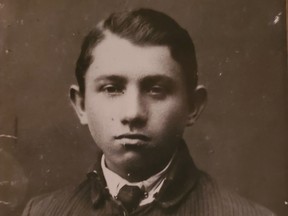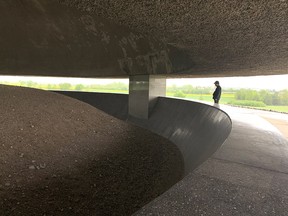How Poland descended into a black box of Jewish extermination led me to visit the homeland of my relatives to learn more about the Holocaust

Article content
POLAND — The afternoon sun broke through northern Poland’s grey skies as we walked into a golden-yellow field hedged by massive evergreens. Birds quietly chirped in the brush. Some in the group were draped in Canadian and Israeli flags as we entered the clearing where Chełmno once stood.
Chełmno was the first death camp created by the Nazis in 1941, a year before the Wannsee Conference where German leaders hammered out the logistics of implementing the “Final Solution” to eradicate European Jews. Six million Jewish people would be killed in the Holocaust by the Nazis and their collaborators.
Advertisement 2
Article content
Chełmno was a testing ground for the Nazi industrialization of mass murder, a place where they experimented with poison gas, piping it into large vans filled with stripped-naked prisoners.
“At some point, they were told not to undress any longer. There’s no more room,” reads the testimony of one Sonderkommando, Jewish prisoners forced by the Nazis to help with manual labour. The man was tasked with digging a mass grave when some of the remaining Jews, still alive, were thrown on top of the death heap.
“And then a truck came from the road and when the truck arrived, it had two big vats on it, and it started pouring something onto them. I thought it was water; that’s what it looked like.”
It was lime, a compound of calcium hydroxide. People were burned alive. The screams were so unbearable for the Sonderkommando that he tore garments from a pile left by the victims and stuck them in his ears to drown out their death cries.
The Nazis sought to cover up their crimes and destroy any trace of Chełmno. Graves were exhumed, bones crushed by massive machines, and the detritus of life burned or dumped in nearby rivers. An estimated 172,000 people were murdered at the killing site (including Romani victims).
Advertisement 3
Article content
Not all the fragments of humanity were disposed of as the Nazis fled the advancing Red Army in January 1945. Remnants of the murdered are still scattered across this bucolic Polish landscape that was once a country estate. We scoured the soft earth for bone chips. I found three splinters and held them in my palm. I wondered who they belonged to and what they thought about before their world was destroyed.

We placed them in a burial site and sang Kaddish, a Jewish prayer of mourning.
We had come to Poland to see the graveyard of our ancestors. We were the lucky ones, descendents of those who managed to escape before most of European Jewry was extinguished in the Second World War. This country of green forests and crystalline lakes that cradled Jewish life for centuries was fondly remembered by those who left in the prewar years as Po-Lan-Ya, “Here rests God.” Legend has it that when Jews emigrated, turning their backs on the homeland, birds would chirp Po-Lin, Po-Lin, “Here rests, Here rests” in Hebrew, as they left, embodying the beauty and love many Jews had for this land.
How Poland descended into a black box of Jewish extermination led me to join the Living Legacy Experience, a tour bringing Canadian Jews of all ages to learn about the Holocaust. In the group were mothers and daughters, grandparents and grandchildren, and brothers in my case.
Article content
Advertisement 4
Article content
I’d come because I wanted to understand what it meant to be a Jew on the eve of destruction; what life felt like for the millions living in shtetls, small towns scattered across Eastern Europe where Jews often represented the majority of inhabitants. I was tired of reaching for dusty family history books, tracing genealogies of people I didn’t know from black-and-white photos.
Leibish Tauber, Chaya Malke, Sheindal Blaff. Who were these people whose names I struggled to pronounce? What did their lives look like? Where do I fit into this picture?
I don’t know how many family members were lost in the Holocaust. My paternal great-grandfather, Hyman Blaff (“Gramps”), left Grabowitz, a shtetl near the modern-day Polish-Ukrainian border in 1921, arriving at Ellis Island. He followed in his parents’ footsteps, building a life in New York City.

Virtually all of Gramps’ cousins, uncles, aunts and friends disappeared in the Holocaust. Their little town caught along the hypotenuse of a deadly triangle connecting Bełźec, Majdanek, and Sobibor, three of the six extermination camps built by the Nazis.
Advertisement 5
Article content
“Their total disappearance was a big mystery for which we could find no clues,” Charlotte Bendayan, his 95-year-old daughter, my great-aunt, told me by email. She had spoken to one lady in Toronto who heard rumours Hyman’s sister Rivka “was shot while trying to flee” after a Pole informed German authorities of her whereabouts.
Trying to find out what happened to most Holocaust victims is, in many cases, impossible. My maternal great-grandmother, Jennie Jacobson, left Dorbyan, Lithuania, in 1920, saying goodbye to her siblings, mother, and nearly a hundred relatives. Inspired by the promise of new beginnings, she came to Canada and settled in the Maritimes. As the family joke goes, that’s where the poor Jews stayed while the wealthier ones settled in Montreal and Toronto.
Following the German invasion of Lithuania in June 1941, Jennie’s family was likely murdered by Einsatzgruppen, Nazi death squads charged with exterminating Jewish communities in newly occupied territories, aided by local militias. Before year’s end, all the Jews of Dorbyan were likely killed.
Advertisement 6
Article content

“The Lithuanians used sticks to beat everyone. The second Jew to be killed was Rabbi Isaac Weisberg. The German soldiers with guns went to his house and shaved one side of his face. They shaved off not only his beard but skin and flesh. They then proceeded to beat him until he was dead. They dragged his body to the square where everyone was assembled,” the volume Yahadut Lita, published in 1959 by the Association of the Lithuanian Jews in Israel, tells us.
“The people of Dorbyan are two kinds,” Holocaust survivor Itzchak Yacobi reflected decades later. “Those who stayed there to live their lives to the bitter end and those who left at a young age to live in Canada, United States, and South Africa.”
Jennie kept in touch with her family “through the eventful years,” cousin Deborah David told me, updating them on the milestones in her life — marriage, the birth of five children, the death of her husband in 1933. She cherished those transatlantic letters, written in Yiddish, saving them the rest of her life. At some point, her correspondence went unanswered. It was left for her to fill in the vacuum of history left by the Second World War.
Advertisement 7
Article content
Łódź Ghetto
After Chełmno, our next stop was the Łódź Ghetto. Many of Chełmno’s victims came from Łódź, a once-bustling Jewish town a couple hours outside Warsaw. The Nazis had forced 160,000 Jews to crowd into the ghetto in early 1940 until they were shipped off to their deaths. The cemetery in the town’s northeastern outskirts is one of the few sites testifying to the community’s existence.
It seemed as if no one had visited the site since the war, a scab best left forgotten. Giant slugs crawled over the grounds, where waist-high grass made tombstones unreadable. Several of the paths were a tangle of overgrowth as we plodded our way past the graves of distinguished rabbis and philanthropists.
We gathered in an old synagogue on the property. Yellow and blue stained-glass windows refracted in the warm spring sunlight as Yitzi Kempinski, our Israeli tour guide, explained why there was minimal resistance. “Remember, the Jews at the beginning don’t know what it means, that sticking together is actually going to kill them.”

Majdanek
It was a rainy day when we visited Majdanek, and I was glad of it. How else to tour a death camp? Majdanek, on the outskirts of the city of Lublin, was a concentration camp that was later converted into an extermination camp, claiming the lives of roughly 80,000 people, including non-Jewish prisoners of war.
Advertisement 8
Article content
Majdanek’s a rare site the Nazis didn’t have enough time to destroy and hide their crimes. The wooden floors still creak when you walk through its well-preserved barracks; the pressurized doors to the gas chambers are kept open wide enough for visitors to see the nail marks notched on the walls.
It’s the perverseness of the Nazi’s designs that strikes one here. At the crematoria, we learn about how the bodies were brought to concrete slabs where gold teeth fillings, rings and other valuables were ripped off corpses before they were carted to the next room, where a bank of ovens incinerated the bodies.
It’s these disturbing details one grasps when struggling to make sense of six million lives lost. Why were prisoners brought to Auschwitz greeted by a seven-piece orchestra featuring a violin, saxophone, and accordion? Why did Nazis place a large curtain stripped from an ark housing a Torah scroll outside the Treblinka gas chamber? The words on the curtain reassured unsuspecting Jews on death’s doorstep: “This is the gate of the Lord through which the righteous shall enter.”
Advertisement 9
Article content

Finding joy
Somehow, as Jews do, we still found moments of joy.
In Łańcut, a well-preserved shul in eastern Poland, two on the trip got bar mitzvahed, a coming-of-age ritual for Jewish boys, traditionally done at age 13. It was held at the famed Łańcut synagogue. The young men were blessed by four Holocaust survivors and lifted on chairs as people danced the hora, locking hands in a circle around them.
Josef Levkovich, a survivor of six concentration camps, orchestrated the festivities. A diamond dealer, Nazi hunter, author and longtime Montrealer, Levkovich moved to Israel at the age of 87. A famous traditional Jewish musician happened to be passing through town and serenaded us as Levkovich, then 96 and barely five-feet tall, conducted the operation, waving his hands back and forth. Levkovich passed away on Dec. 26, at the age of 98.
Bełżec
We pushed eastward to Bełżec, a death camp that sits a few miles from the Ukrainian border, where at least half a million Jews were slaughtered. The site was destroyed by the Nazis. A few photos in the visitor’s centre help visitors imagine what once stood here. Possibly a dozen survivors managed to escape Bełżec and testified to the crimes they witnessed.
Advertisement 10
Article content
Bełżec, Holocaust historian David Silberklang writes, “was perhaps the place most representative of the totality and finality of the Nazi plans for Jews. In fact, Bełżec was the only one of the death camps in which the assigned tasks were actually completed, and therefore was shut down by the Nazis.”

The monument to commemorate Bełżec is a field of strewn rubble, black stones and twisted wire. Bisecting it is a pathway descending into the bowels of the earth, where the gas chambers were located. The Nazis tried to plant trees over this cursed land to hide their crimes, but all except witness trees — those that existed at the time of the death camp’s operation — were felled by preservationists.
The visit was a first for Marion Weinzweig, a survivor who hid in a convent during the war. “Being here, I can’t tell you what that does to me,” the octagenarian said, gesturing at photos of the family that she lost. Flipping through the pages, she showed row upon row of relatives, the names highlighted in yellow — “aunts, uncles, cousins” — murdered here.
“The first thing I did — I didn’t go with any of you guys — I crawled over there,” said Weinzweig, who lives in Phoenix, Az, pointing to the stones behind her. “I went right into the dirt, and I got myself some dirt from Bełżec. I also have dirt from Treblinka,” she continued as rain fell in fat drops. “When I die, I’ve got dirt both from Bełżec and Treblinka, where my father’s family died, and it’s going to be put on me.”
Advertisement 11
Article content
“They all disappeared here, my whole family,” said Levkovich of Bełżec, while standing and resting his elbows on his wheelchair. He wore a black fedora, sepia-toned glasses and leather gloves, a man built in a different generation.

We walked to the site of the gas chamber as the ground slowly enveloped us, the earthen walls inching nearing the epicentre of the Final Solution. Several women, including Weinzweig, were bat mitzvahed at the site. They each took a Hebrew name, reconsecrating a site of death into one of spiritual rebirth.
It turns out that some of Gramps’ family likely met their fate here, though I would find that out later.
“For the Jews of Grabowitz, the last days and weeks before the outbreak of the war between Germany and Poland, in 1939, were a nightmare,” wrote one survivor from his town. “Everybody knew that the first to suffer from this war, if it broke out, would be the sons of the people Hitler planned to destroy. Reports about the persecutions of the Jews in Germany had reached Grabowitz and stirred fear in the hearts of the Jews of the town.”
These were Gramps’ neighbours, the people who coloured his stories of shtetl life. He recalled Grabowitz as a village less “developed than other Polish shtetls,” marred by a “pot-holed road (that) made contact with the outside world rather difficult.”
Advertisement 12
Article content
I recently learned Gramps led Grabowitz’s Yizkor committee, a practice embraced by Jewish communities after the Holocaust to preserve memories of towns that once were and would never be again. Gramps wrote the book’s first entry as well as chapters on prewar life and was credited with giving the group “much encouragement and moral and material assistance.”
Indeed, Gramps was a remarkable writer, sketching out portraits that revealed the rhythm of life in Grabowitz. “The marketplace awakened and with it, the lanes,” he wrote. “Quick steps were heard; a pale greyish light was shed on the sleepy houses and shops. A new day arose over Grabowitz and the Jews hurried to welcome it in prayer to G–d the Almighty.
“All gates, doors and windows were flung open and the everyday life of the Jews in the shtetl began. Some walked slowly as if counting each step, breathing heavily, sighing, stopping to inhale fresh air prior to entering the Prayer House; others, in haste, reached the synagogues, hurriedly said their prayers, swallowing half of the words in order to manage to arrive first at the village.”
Advertisement 13
Article content
We didn’t get to see Grabowitz, driving within kilometres of it, but I can picture it now.
It was difficult reading Gramps’ words after the trip. I felt the loss — his and mine — of the cousins we never knew, their horrific deaths, and the helplessness he must have felt stuck in America.
“Whenever you want to discuss more, I am here. Gramps would have been so proud of you. He admired writers,” his daughter Charlotte wrote before she passed away last November.
But he never got to hear how proud I was of him, how his decision to leave behind Grabowitz and Poland led to a grandson he never knew, pouring over his writings to learn about the man he was.
Recommended from Editorial
-

Young Canadians most likely to be Holocaust skeptics, poll finds
-

How TDSB embraced ‘anti-Palestinian racism’ policies — and sparked debate about antisemitism
Our website is the place for the latest breaking news, exclusive scoops, longreads and provocative commentary. Please bookmark nationalpost.com and sign up for our daily newsletter, Posted, here.
Article content
#pilgrimmage #Poland #burial #grounds #Jews













Leave a Reply